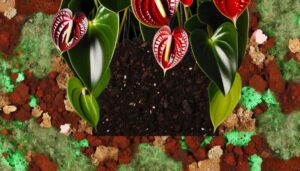Top 3 Tips for Anthurium Clavigerum Care
To care for your Anthurium clavigerum, make sure it gets bright, indirect light, ideally from a north or east-facing window. Direct sunlight can scorch its leaves.
Water when the top inch of soil is dry using room-temperature water and make certain the pot has drainage holes to prevent root rot. Watch for seasonal changes and adjust watering accordingly.
Finally, maintain 60-80% humidity with a humidifier or a water tray with pebbles, and avoid dry air from heating vents. Consistent humidity prevents browning leaf edges and promotes growth.
For more nuanced details about its care, explore further insights.

Key Takeaways
- Place Anthurium clavigerum in bright, indirect light to prevent leaf scorching.
- Water when the top inch of soil is dry, using room-temperature water.
- Maintain 60-80% relative humidity using a humidifier or pebble trays.
- Ensure pots have drainage holes to prevent waterlogging and root rot.
- Avoid placing the plant near heating vents or air conditioners to maintain humidity.
Provide Optimal Light
To ensure your Anthurium clavigerum thrives, you should regularly provide it with bright, indirect light. This plant naturally grows under the canopy of tropical rainforests, where it receives dappled sunlight.
Direct sunlight can scorch its leaves, so place it near a north or east-facing window, or use sheer curtains to diffuse the light. If natural light is inadequate, full-spectrum grow lights can be an excellent alternative. Position the light source about 12-18 inches away from the plant.
Consistent exposure to the right light conditions promotes robust growth and vibrant foliage. Observe your Anthurium's leaves; yellowing may indicate too much light, while dark green, leggy growth suggests insufficient lighting. Adjust accordingly for optimal health.
Watering Techniques
Properly watering your Anthurium clavigerum is crucial for maintaining its health and preventing root rot. You should water the plant when the top inch of soil feels dry. Use room-temperature water to avoid shocking the roots. Confirm the pot has drainage holes to prevent waterlogging, which can lead to root rot.
| Watering Technique | Description |
|---|---|
| Frequency | Water when the top inch of soil is dry |
| Water Temperature | Use room-temperature water |
| Drainage | Confirm the pot has drainage holes |
Monitor the plant closely, especially during seasonal changes, as the watering frequency may need adjustment. Overwatering is a common mistake; always err on the side of caution. A well-balanced watering routine supports vibrant foliage and robust growth.
Maintain Humidity Levels
Maintaining ideal humidity levels is just as crucial as proper watering to guarantee your Anthurium clavigerum thrives. Aim for a relative humidity of 60-80% to replicate its natural tropical environment.
You can achieve this by using a humidifier, placing the plant on a tray filled with water and pebbles, or regularly misting the leaves. Monitor humidity with a hygrometer to ensure consistency. Avoid placing your plant near heating vents or air conditioners, which can dry out the air.
If humidity drops too low, you might notice browning leaf edges or slower growth. High humidity enhances transpiration and nutrient uptake, promoting lush foliage and overall health. By regulating humidity, you'll help your Anthurium clavigerum flourish.
Conclusion
Caring for your Anthurium clavigerum can be a rewarding experience when you provide ideal light, use proper watering techniques, and maintain high humidity levels.
Did you know that Anthuriums can increase indoor humidity by up to 5%? This not only benefits the plant but also improves air quality in your home.
By following these tips, you'll create a thriving environment for your Anthurium clavigerum, ensuring it remains lush and vibrant year-round.






